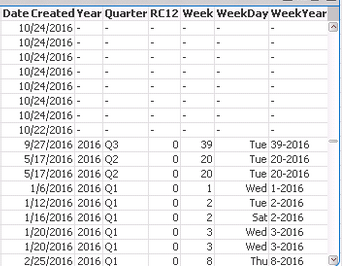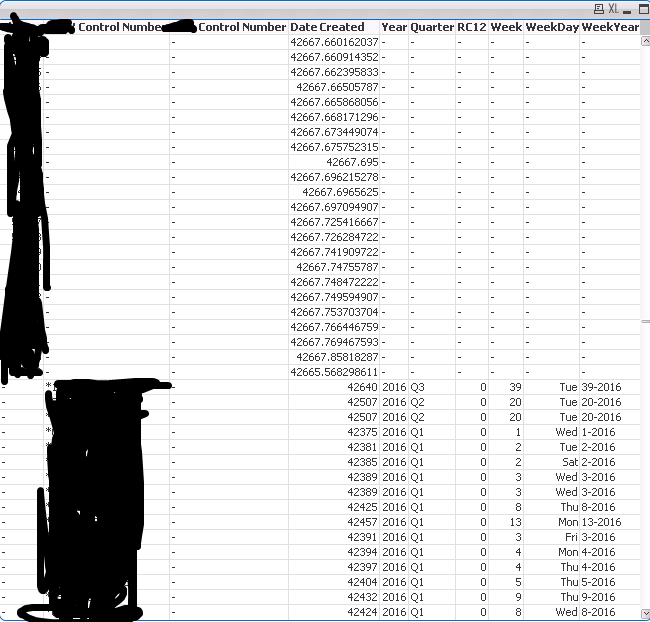Unlock a world of possibilities! Login now and discover the exclusive benefits awaiting you.
- Qlik Community
- :
- All Forums
- :
- QlikView App Dev
- :
- Re: Master Calendar Not linking correctly to Fact ...
- Subscribe to RSS Feed
- Mark Topic as New
- Mark Topic as Read
- Float this Topic for Current User
- Bookmark
- Subscribe
- Mute
- Printer Friendly Page
- Mark as New
- Bookmark
- Subscribe
- Mute
- Subscribe to RSS Feed
- Permalink
- Report Inappropriate Content
Master Calendar Not linking correctly to Fact Table
I have one fact table (I concatenated 3 tables of data, because there is no (actual) Pkey, but wanted to simplify my data model, and eliminate Syntehtic keys).
My fact table has some fields that will align, i.e. Date Created, some other dates, etc. It seems that for the most part my fact table has produced desirable results ( i did most of my calculations with the tables separated, I have just recently tried to clean everything up).
During this process I have tried to create a Master Calendar.... It seems that it is functioning properly with two of the tables that were concatenated, but not with one of them, even though the master calendar is created off of the same field. has anyone else had this issues?
See picture below:

It's return NULL values for my table that contains a Pkey, but the other two, the two variables following Pkey that say Control Number, each have a Month, year, quarter, etc, linking them based on Date Created. I'm confused because Date Created is what I used to create the master calendar, so how can it be working for some data, (from two different tables) , but not the other
ex code:
Final_Data_Model:
LOAD
DATE([DateCreated]) AS [Date Created],
FROM $(vQVDPath)ABCData.qvd (QVD);
CONCATENATE
LOAD
DATE([Date Created]) AS [Date Created],
FROM $(vQVDPath)DEFData.qvd (QVD);
CONCATENATE
LOAD
DATE([Date Sent]) AS [Date Created],
FROM $(vQVDPath)GHIData.qvd (QVD);
| IF NoOfRows('Final_Data_Model') > 0 THEN |
STORE Final_Data_Model INTO $(vQVDPath)Final_Data_Model.qvd (QVD);
END IF ;
////// MASTER CALENDAR LOAD
QuartersMap:
MAPPING LOAD
ROWNO() AS Month,
'Q' & CEIL (ROWNO()/3) AS Quarter
AUTOGENERATE (12);
Temp:
LOAD
MIN([Date Created]) AS minDate,
MAX([Date Created]) AS maxDate
RESIDENT Final_Data_Model;
LET varMinDate = PEEK('minDate', 0, 'Temp');
LET varMaxDate = PEEK('maxDate', 0, 'Temp');
//DROP TABLE Temp;
TempCalendar:
LOAD
$(varMinDate) + ITERNO()-1 AS Num,
DATE($(varMinDate) + ITERNO() - 1) AS TempDate
AUTOGENERATE 1 WHILE $(varMinDate) + ITERNO() -1 <= $(varMaxDate);
TempCal:
LOAD
date($(varMinDate) + rowno() - 1) AS TempDate
AUTOGENERATE
$(varMaxDate) - $(varMinDate) + 1;
MasterCalendar:
Load
TempDate AS [Date Created],
WEEK(TempDate) AS Week,
YEAR(TempDate) AS Year,
MONTH(TempDate) AS Month,
DAY(TempDate) As Day,
YEARTODATE(TempDate)*-1 AS CurYTDFlag,
YEARTODATE(TempDate,-1)*-1 AS LastYTDFlag,
INYEAR(TempDate, MONTHSTART($(varMaxDate)),-1) AS RC12,
DATE(MONTHSTART(TempDate), 'MMM-YYYY') AS MonthYear,
APPLYMAP('QuartersMap', MONTH(TempDate), NULL()) AS Quarter,
WEEK(WEEKSTART(TempDate)) & '-' & WEEKYEAR(TempDate) AS WeekYear,
WEEKDAY(TempDate) AS WeekDay
RESIDENT TempCal
ORDER BY TempDate ASC;
//DROP TABLE TempCal;
STORE MasterCalendar INTO $(vQVDPath)MasterCalendar.qvd (QVD);
- « Previous Replies
-
- 1
- 2
- Next Replies »
Accepted Solutions
- Mark as New
- Bookmark
- Subscribe
- Mute
- Subscribe to RSS Feed
- Permalink
- Report Inappropriate Content
use the floor() function for [date created] and add another local field without the floor() function.
SO you can keep the hours, minutes and seconds...
- Mark as New
- Bookmark
- Subscribe
- Mute
- Subscribe to RSS Feed
- Permalink
- Report Inappropriate Content
Can you share the sample data or sample qvw?
- Mark as New
- Bookmark
- Subscribe
- Mute
- Subscribe to RSS Feed
- Permalink
- Report Inappropriate Content
The picture shows sample data. I don't believe I'll be able to share a sample QVW unless I really took everything out of it... The weird thing is, is that for SOME of the data, where Pkey IS NOT NULL, there are values for Month, Year, etc. but for 99% of them, all date fields (aside from Date Created) is NULL.... But with both Control Number fields, every Date Created field has a matching Month, year, quarter, etc...
- Mark as New
- Bookmark
- Subscribe
- Mute
- Subscribe to RSS Feed
- Permalink
- Report Inappropriate Content
just change the format of "date created" to number

and post the result the following table again

- Mark as New
- Bookmark
- Subscribe
- Mute
- Subscribe to RSS Feed
- Permalink
- Report Inappropriate Content
ex code:
Final_Data_Model:
LOAD
DATE([DateCreated]) AS [Date Created],
FROM $(vQVDPath)ABCData.qvd (QVD);
CONCATENATE
LOAD
DATE([Date Created]) AS [Date Created],
FROM $(vQVDPath)DEFData.qvd (QVD);
CONCATENATE
LOAD
DATE([Date Sent]) AS [Date Created],
FROM $(vQVDPath)GHIData.qvd (QVD);
| IF NoOfRows('Final_Data_Model') > 0 THEN |
STORE Final_Data_Model INTO $(vQVDPath)Final_Data_Model.qvd (QVD);
END IF
where not "[Date Created]"='';
////// MASTER CALENDAR LOAD
// Date Dimension
// to load Quarters Full Name
QuarterNAME:
LOAD * Inline [
Quarter , QuarterFullName
Q1 ,FIRST
Q2 ,SECOND
Q3 ,THIRD
Q4 ,FOURTH
];
// to create Quarters ie Q1,Q2
QuartersMap:
MAPPING LOAD
rowno() as Month,
'Q' & Ceil (rowno()/3) as Quarter
AUTOGENERATE (12);
varMinDate = num(date(mid('10-24-2016',1,10 ),'MM-DD-YYYY'));
varMaxDate = num(date(today(),'MM-DD-YYYY'));
// Creating a Temporary Calendar
TempCalendar:
LOAD
$(varMinDate) + Iterno()-1 as Num,
Date($(varMinDate) + IterNo() - 1) as TempDate
AutoGenerate 1 While $(varMinDate) + IterNo() -1 <= $(varMaxDate);
// Date Dimension
MasterCalendar:
LOAD*,
AutoNumber ([Year Month Num], 'PeriodID') as PeriodID,
AutoNumber (Year & Quarter, 'QuarterID') as QuarterID;
Load
trim(date(TempDate,'YYYY-MM-DD')) as [Date Created],
date(TempDate,'YYYY-MM-DD') as [Effective Date],
day(TempDate) as Day,
TempDate as [US Calendar Format],
date(TempDate,'YYYY-MM-DD') as [UK Calendar Format],
date(TempDate,'WWWW') as [Full Day Name],
year(TempDate) as Year,
inyear(TempDate,today(),0) * -1 as [CY], // Current Year
inyear(TempDate,today(),-1) * -1 as [First PY],
inyear(TempDate,today(),-2) * -1 as [Second PY],
inyeartodate(TempDate,today(),0) * -1 as [CYTD],
inyeartodate(TempDate,today(),-1) * -1 as [First PYTD],
inyeartodate(TempDate,today(),-2) * -1 as [Second PYTD],
ApplyMap('QuartersMap', month(TempDate), Null()) as Quarter,
Ceil(Month(TempDate)/3) as [Quarter Number],
quarterName(TempDate) as [Quarter Name],
yearname(TempDate) & 'Q' & Ceil(Month(TempDate)/3) as [Quarter Year],
inquarter(TempDate,today(),0) * -1 as [CQ], // Current Quarter
inquarter(TempDate,today(),-4) * -1 as [First PQ],
inquarter(TempDate,today(),-8) * -1 as [Second PQ],
inquartertodate(TempDate,today(),0) * -1 as [CQTD],
inquartertodate(TempDate,today(),-4) * -1 as [First PQTD],
inquartertodate(TempDate,today(),-8) * -1 as [Second PQTD],
date(monthstart(TempDate),'MM') as [Month Number],
num(month(TempDate)) as Num_Month,
month(TempDate) as Month,
date(monthstart(TempDate),'MMMM') as [Month Full Name],
monthstart(TempDate) as [Calendar Month Start Date],
monthend(TempDate) as [Calendar Month End Date],
date(monthstart(TempDate), 'MMM-YYYY') as [Month Year],
date(monthstart(TempDate), 'YYYYMM') as [Year Month Num],
week(TempDate) as Week,
week(weekstart(TempDate)) & '-' & WeekYear(TempDate) as [Week Year],
week(weekstart(TempDate)) & '-' & Month(TempDate) as [Week Month],
weekDay(TempDate) as [Week Day],
If( TempDate > monthstart(addmonths(today(),-11)) and TempDate <= today(),1) as [Rolling 12]
Resident TempCalendar
Order By TempDate ASC;
Drop Table TempCalendar;
Drop Table QuarterNAME;
Table3:
LOAD
*
RESIDENT MasterCalendar
WHERE not Exists([Date Created]);
STORE MasterCalendar INTO $(vQVDPath)MasterCalendar.qvd (QVD);
- Mark as New
- Bookmark
- Subscribe
- Mute
- Subscribe to RSS Feed
- Permalink
- Report Inappropriate Content
I think I've found the problem:
I took the DATE format off of all of my [Date Created] fields. For the two tables that work, the unformatted date is a WHOLE number, and the dates that aren't working contain decimals. I believe it to be important to not format my date that contains decimals with FLOOR or CEIL because I would like to maintain the hours, minutes, seconds, for grouping purposes..... Do Master Calendar's not work with dates formatted in this manner?

- Mark as New
- Bookmark
- Subscribe
- Mute
- Subscribe to RSS Feed
- Permalink
- Report Inappropriate Content
I'm not sure if the script I posted will help or not.
Cus I had same situation where I didn't had DATEKey to link MC. So I used below script. But my data was different, I do not know about your data.
Also please check the Date format for Qlikview with your Master Calendar date format and Data Date format.
Thanks.
- Mark as New
- Bookmark
- Subscribe
- Mute
- Subscribe to RSS Feed
- Permalink
- Report Inappropriate Content
use the floor() function for [date created] and add another local field without the floor() function.
SO you can keep the hours, minutes and seconds...
- Mark as New
- Bookmark
- Subscribe
- Mute
- Subscribe to RSS Feed
- Permalink
- Report Inappropriate Content
This seems like a drawback of the Master Calendar, if you can't use dates other than strict formatting of integers, then this can cause issues....
- Mark as New
- Bookmark
- Subscribe
- Mute
- Subscribe to RSS Feed
- Permalink
- Report Inappropriate Content
Use this in Master Calendar
Date(TempDate, 'MM-DD-YYYY - h:mm:ss TT') as [Date Created],
Please verify the Date format with your data.
- « Previous Replies
-
- 1
- 2
- Next Replies »